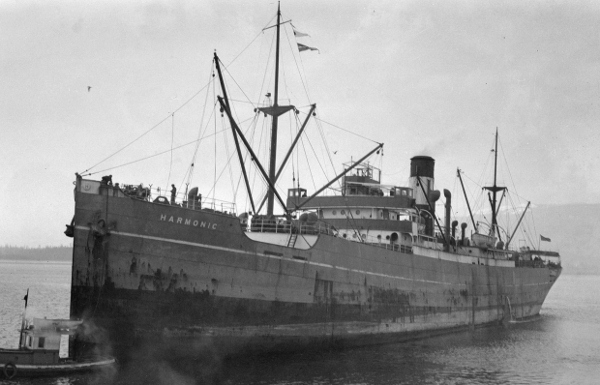Harmonic
British Steam merchant

Photo from City of Vancouver Archives, CVA 447-2273
| Name | Harmonic | ||
| Type: | Steam merchant | ||
| Tonnage | 4,558 tons | ||
| Completed | 1930 - Robert Thompson & Sons, Bridge Dockyard, Sunderland | ||
| Owner | J. & C. Harrison Ltd, London | ||
| Homeport | London | ||
| Date of attack | 15 Jul 1943 | Nationality: | |
| Fate | Sunk by U-172 (Carl Emmermann) | ||
| Position | 23° 00'S, 33° 00'W - Grid GC 1613 | ||
| Complement | 47 (1 dead and 46 survivors). | ||
| Convoy | |||
| Route | Rosario - Buenos Aires (7 Jul) - Freetown - UK | ||
| Cargo | 7368 tons of linseed oil | ||
| History | Completed in August 1930. On 10 Jul 1940, the Harmonic in convoy OA-180 picked up the survivors of the Alwaki which had been torpedoed by U-61 (Oesten) in the same convoy off Cape Wrath. | ||
| Notes on event | At 20.43 hours on 15 July 1943 the unescorted Harmonic (Master Roland Stott) was hit on the port side by one of two G7e torpedoes from U-172 while steaming on a non-evasive course at 9 knots about 600 miles east of Rio de Janeiro. The torpedo struck amidships at the bulkhead between the stokehold and cross bunker and the explosion shattered the port side of the bridge, the wireless room and both port lifeboats, blew off #3 hatches and threw a large amount of linseed into the air, stopped the engines and killed a fireman on watch below. The ship took a heavy list to port as the boiler room flooded and the master, 38 crew members and six gunners (the ship was armed with one 4in, one 12pdr, two 20mm and four machine guns) abandoned ship in the starboard aft motor lifeboat as the starboard forward boat could not be launched due to the list. The chief officer jumped overboard and swam to a raft, he was later picked up by the boat. At 21.26 hours, the ship was struck on the starboard side in #1 hold by a coup de grâce that threw a lot of debris into the air and caused her to sink almost immediately by the bow after rolling over to port. The U-boat surfaced afterwards, ordered the lifeboat to come alongside and took the second officer aboard for questioning who told the Germans that master had been lost. Their offer to treat a survivor with a head wound was declined. They apologized to him for sinking the vessel and wished the survivors good luck after returning the officer to the boat. After the U-boat had left, the lifeboat headed for the Brazilian coast, using the motor and sending distress signals with the emergency wireless set. On 17 July, they had to set sail after the petrol ran out and soon the battery of the wireless set gave out. Two days later the weather deteriorated for a day, the wind increasing to a full gale with a very high sea, making it necessary for the boat to hove to with a sea anchor and forcing the survivors to pump and bail continuously to prevent the overcrowded boat from capsizing. They continued to row and sail towards the coast until sighting land during the early hours of 22 July, shortly afterwards the survivors attracted the attention of the Portuguese steam merchant Inhambane by smoke floats, were picked up by the vessel after having sailed some 460 miles and landed two days later at Bahia, Brazil. Everyone suffered from stiffness in their leg joints due to the cramped conditions in the boat and were unable to walk at first, but this soon wore off. | ||
| On board | We have details of 8 people who were on board. | ||
If you can help us with any additional information on this vessel then please contact us.
